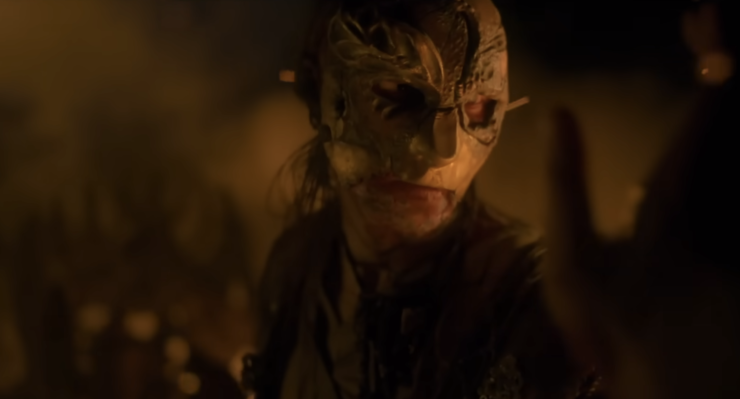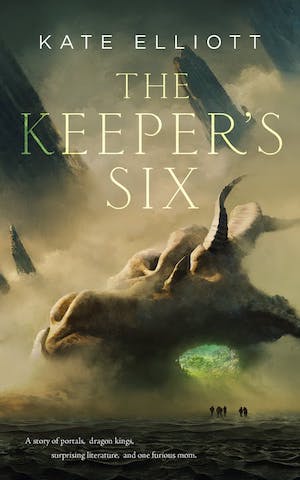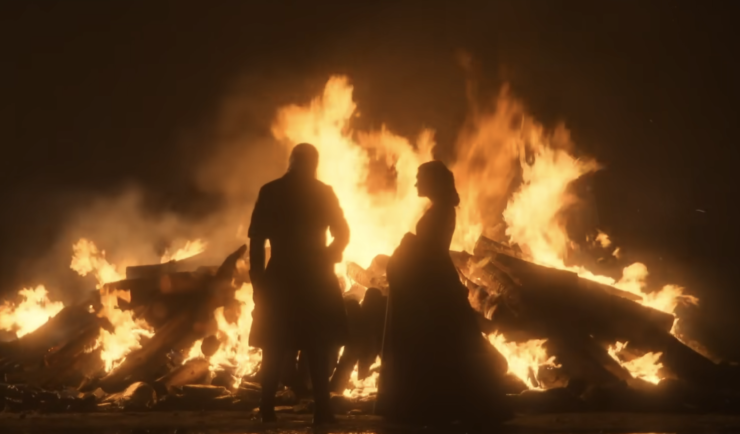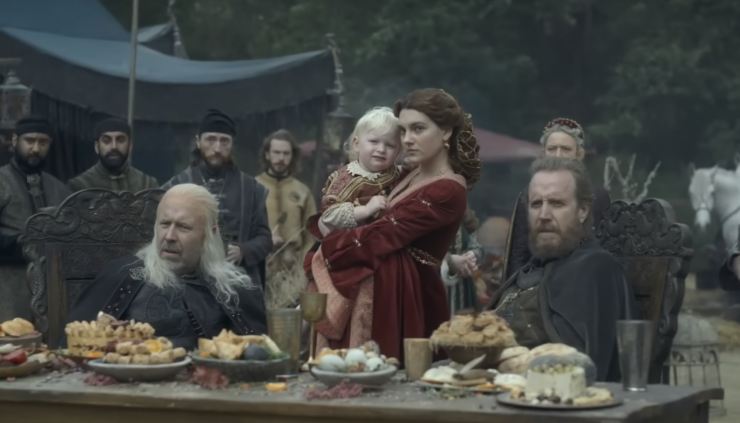This week, House of the Dragon gave us an episode about rising tensions in the looming Targaryen succession crisis, a meditation on medieval signs and portents, and a thrilling battle where Matt Smith’s Daemon Targaryen knocked it out of the park without a single line of dialogue. So let’s dig into some of the vital bits of lore, legend, and history that are layered into the events and revelations of “Second of His Name”—starting with the episode’s title.
The Title
“Second of His Name” refers, of course, to the two-year-old Aegon Targaryen, the first child of Viserys (Paddy Considine) and his new queen, Alicent (played here by Emily Carey). He is named for Aegon Targaryen, also known as Aegon the Conqueror, who was the first Targaryen king of Westeros. The episode title is a bit of foreshadowing, however: There was a Targaryen prince named Aegon between the original and this child—the brother of King Jaehaerys I, making him Viserys I’s great-uncle. But this Aegon was never crowned king (and is even known to history as Aegon the Uncrowned) and therefore did not need the style of “second of his name.” By using that phrase as the title of the episode, despite the fact that the toddler Aegon is not king, the show seems to echo or reinforce Rhaenyra’s assertion that her half-brother being named heir is a foregone conclusion.
The Crabfeeder

Craghas Drahar, the Crabfeeder (Daniel Scott-Smith), is not much discussed in Fire & Blood. Martin tells us that that the Triarchy armies and fleets were commanded by “the Myrish prince admiral, Craghas Drahar, who earned the sobriquet Craghas Crabfeeder when he staked out hundreds of captured pirates on the wet sands to drown beneath the rising tide.” That’s right folks, in Martin’s original, he just drowns men—no gruesomely literal crab-feeding to speak of. In this version, Drahar fits the model of a number of Pirate and Triarchy princes who control the largest of the Stepstones, Bloodstone, throughout the history of Westeros. Clearly the show needed to make the Crabfeeder a more interesting, more memorable character, and one that appears threatening enough to worry the experienced Corlys Velaryon.
When looking at the ways in which the show might reimagine the Crabfeeder, I initially thought they might model him off of the flamboyant, queer, thoroughly charming Tyroshi captain, Racallio Ryndoon, another pirate prince of the Stepstones who appears in Fire & Blood but just after the time period that would be covered by the show. The show has opted, instead, to make the Crabfeeder an amalgam of some of the most interesting bits of A Song of Ice and Fire lore that aren’t likely to find purchase in the rest of House of the Dragon’s scope but add some intriguing details to the story of the Myrish Prince. Let’s start with that mask:
The Mask
Craghas Drahar’s iconic mask appears to be a chimerical mix of several different leather masks stitched together. Of particular note is the right side that looks like it was made from the Sons of Harpy’s facewear. Of course, the Sons of the Harpy—who, in the original series, were an insurgent terrorist group that formed to overthrow Daenerys Targaryen’s rule in Mereen—won’t exist for another hundred and ninety or so years. Perhaps they patterned their masks off of some Old Ghiscari order. Either way, it confirms that the Crabfeeder is well traveled and has perhaps been to Slaver’s Bay on the other side of the Valyrian peninsula, which makes sense when we consider the next notable thing about him…
Greyscale
The Crabfeeder appears to be in the advanced stages of greyscale infection. Greyscale is a degenerative disease in Martin’s world that causes the afflicted to break out into patches of gray, stone-like skin that eventually overwhelm the brain and other vital organs, resulting in madness or death. In the original series, both Stannis’ daughter, Shireen Baratheon (Kerry Ingram), and Ser Jorah Mormont (Iain Glen) suffer from the disease. In both cases, they are cured but disfigured by it. In Martin’s books, Shireen is, indeed, a miraculous survivor of the affliction. In the books, though, Jorah Mormont never contracts the disease; the show most likely combined his story with that of exiled lord Jon Connington, whose plotline included a (possibly) false Targaryen heir, the Golden Company mercenaries, and Tyrion’s journey to Mereen, and was entirely excised from the TV show.
Buy the Book


The Keeper’s Six
In order to pivot away from Jon Connington and Tyrion’s journey through the cursed city of Chroyane, the original series also relocated the Stone Men quarantine colony (filled with the mindless sufferers in the final stages of greyscale who must be separated from others for fear of a full-blown epidemic) from Chroyane to the ruins of Valyria. This is a shame for a couple of reasons.
For one, it removed the creepy history of Chroyane from the world of the show. Once the Festival City of the Ancient Rhoynar people, it was known for great canals and the magnificent Palace of Love. When its people fought and lost the Second Spice War against ancient Valyrian colonizers, the captured Prince Garin was hung from a cage and begged for Mother Rhoyne—the goddess of the river for whom his people were named—to avenge his fallen people. According to legend, the waters rose and drowned the city of Chroyane and its dragonlord conquerors, leaving behind a ruin full of noxious mists that are said to be the cause of the greyscale. The ruins of the city (and particularly a shattered span over the Rhoyne known as the Bridge of Dream) serve as the Stone Men colony, ruled over by a mysterious figure called the Shrouded Lord, who some characters believe is Prince Garin himself, now a minor deity of disease presiding over the cursed affliction he brought down upon his people. Incidentally, the legendary Queen Nymeria of Dorne—whose thousand ships are referenced in the song that Samwell (Jonny Weldon) sings repeatedly to Rhaenyra (Milly Alcock) in this episode–fled from the Valyrians after the Second Spice War, eventually landing at the bottom of Westeros and marrying into House Martell.
The second reason that moving greyscale out of Chroyane and into Valyria is a potential problem for this show is that it demystifies the latter locale. A full explanation of the horrors of Valyria are perhaps something to be discussed at a later time but, for our purposes here, it is worth knowing that Valyria, after the Doom, is a place of dark sorcery and monstrosities. It has the same sort of mystery and menace as Westeros Beyond-the-Wall, but characterized by Fire instead of Ice. With so much focus on Viserys’ model of Valyria and the legacy of the people of the Freehold, the previous series’ version of the setting feels like a potential missed opportunity. With all that said, giving Craghas Drahar greyscale seems to be another nod to his nautical daring—did he pick it up sailing through the ruins of Valyria (or up the Rhoyne)? And being afflicted by a disease intrinsically linked to the cold and damp makes him elementally opposed to Prince Daemon, raining fire down upon the Crabfeeder’s Myrish soldiers.
King Jaehaerys’ Daughters
Lord Lyonel Strong (Gavin Spokes), Viserys’ Master of Laws, offers his brooding king some solace in this episode by saying that King Jaehaerys “ruled over a half century of peace while his children drove him to the edge of madness, his daughters in particular.” Thus far, Lord Lyonel has been a measured, kind, and seemingly politically unambitious voice of reason in the show but this particular observation seems to reveal, intentionally or not, a more ominous view of the current king’s situation when we look at the history in question.
It is true that Jaehaerys gave the realm fifty-five years of relative peace when compared to his bloodthirsty uncle, Maegor the Cruel, or his father and grandfather, Aenys I and Aegon the Conqueror, both with reigns plagued by wars of conquest and succession. It is also true that Jaehaerys was a well-liked monarch who, along with his even better-liked wife, Good Queen Alysanne, instituted a series of reforms that managed to endear the Targaryens to the realm as a whole. But the matter of his daughters is far more dire than the typical parent-child friction that Lyonel makes it out to be.
While the fate of some of the king’s daughters were studies in parental loss and tragedy–Daenerys died of an illness aged six, Alyssa (Viserys’ mother) died giving birth to his and Daemon’s younger brother Aegon, who in turn died in infancy, Maegelle died of greyscale after becoming a septa who ministered to the afflicted–others died or became estranged as a result of Jaehaerys’ own profound shortsightedness.
- Daella, a daughter whom Martin strongly suggests had some form of intellectual disability, was married off to Rodrik Arryn. She eventually gave birth to Aemma Arryn (Sian Brooke), Viserys’ first queen who was killed during the pilot episode in an attempt to save her child at the cost of her own life. Daella’s death served to widen an existing rift between Jaehaerys and Queen Alysanne, who had advocated against the marriage, fearing for her daughter’s well-being and ability to process and consent to sex and childbirth.
- Viserra was betrothed, against her will, to the much older Theomore Manderly in an attempt to keep her from attempting to seduce her older brother, Baelon. She was killed in a riding accident after sneaking out of the Red Keep to have a last night of revelry with her companions.
- And, finally, Saera was involved in a lurid sex scandal with her ladies-in-waiting and a trio of young knights. Jaehaerys’ mishandling of the situation and his rage over her apparent cruelty with regards to the consequences for her friends and lovers led to further clashes that ended with her being forcibly ordained as a septa before fleeing across the Narrow Sea to become a famous sex worker in Lys. Despite Alysanne’s protestations, Jaehaerys refused to mend the rift and also refused to allow his wife to visit her.
The mounting tensions with his daughters led to Jaehaerys and Alysanne’s own estrangement for much of the latter part of his reign and his final years were spent mired in personal regrets. In comparing Viserys to his grandfather with regard to Rhaenyra’s own betrothal, Lyonel Strong is revealing the possible depths of Viserys’ failures rather than mitigating or excusing them. This all seems to hook into one of Martin’s fundamental premises in his Westerosi fiction: good rulers (like Jaehaerys) are often terrible people and weak ones (like Viserys) often make bad decisions out of a desire to be kind.
Dragonriders and Dreamers

After speaking with Lyonel Strong and drinking himself into high dudgeon, Viserys speaks to his wife Allicent about his fears and regrets regarding the succession, saying that “many in my line have been dragonriders. Very few among us have been dreamers. What is the power of a dragon compared with prophecy?” This brings us to our last topic of conversation: the dragonriders and dreamers of the Targaryen line.
Dragon riding is something that Targaryens have done since before they left Valyria. It is also what distinguished them from other survivors of the Doom. The Velaryons, for instance, came to Westeros centuries earlier as the scions of a seafaring trading house and made little difference in the politics of the Seven Kingdoms. Dragon riding is more than just extreme animal handling—the bond between a dragon and its rider is profound and possibly magical. We get a glimpse of this in episode three when Daemon is shot with an arrow and Caraxes writhes and roars in pain.
In the previous episode, Daemon stole a dragon egg to place in the crib of his unborn (and, as it turns out, entirely fictional) child. The practice of placing dragon eggs in the cribs of Targaryen infants is a storied one, supposedly carried out in order to get the hatchlings and the infants to bond. In some cases the pairing of infant and hatchling leads to the former becoming the rider of the latter. Such is the case with Laenor Velaryon, who rides Seasmoke in the third episode. That said, plenty of Dragonriders choose a dragon that was not bonded to them in infancy. We have yet to see the dragon Meleys, but she has been previously ridden by Alyssa Targaryen, Viserys’ mother, before passing to her current rider (who I will not spoil here). Viserys himself was the last rider of Belarion, the Black Dread, a creature so old that it had been born in Valyria before the Doom. Belarion had accepted at least three other riders prior to Viserys (and likely many more, since the records of his riders presented by Martin only go back to Aegon’s Conquest).
Being a dragonrider is taken as a sign of intrinsic worthiness in Martin’s accounts of Westeros and, unlike actual succession to the Iron Throne, it is something that is considered the provenance of both men and women. It actually creates an interesting loophole in which female dragonriders can participate in military campaigns in a way that they would otherwise be excluded from. Potential heirs that have been dragonriders are assumed to be better suited to the position. Heirs who shy away from the beasts may still be decent monarchs, but it certainly is cause for concern.
Enter Viserys I who is, in his own estimation, not much of a dragonrider. In fact, in riding Balerion only the one time—flying the aged dragon three times around King’s Landing, before swearing off the practice forever—Viserys manages to meet the expectations of the realm without becoming something he knows that he is not. Of course, the fact that his brother Daemon and his daughter Rhaenyra are expert dragonriders does leave him in the position of acknowledging one dimension of their fitness to rule that he does not possess. Which might be a part of the reason that he is so desperate to be the recipient of the other hereditary power of the Targaryen line…
Dragon Dreams
“Dragon dreams” are the term that Targaryens use for prophetic visions experienced by members of their line. Prophecy is not unique to the Targaryens—Bran Stark (Isaac Hempstead Wright) and some members of House Reed, in the North, will eventually experience “green dreams” supposedly taught to the Northmen by the Children of the Forest, and adherents of Rh’llor, like Melisandre (Carice van Houten), scry flames to make waking prophetic proclamations with various levels of accuracy—but the few Targaryens born with a penchant for dragon dreams have good reason to believe that they are, in fact, seeing into the future.
The entire reason the Targaryen line survived the Doom is because Daenys Targaryen (afterwards called Daenys the Dreamer) dreamt that Valyria would be destroyed, causing her father, the Dragonlord Aenar Targaryen, to move his holdings across the Narrow Sea to Dragonstone. Similarly, Aegon the Conqueror had a dream that is undescribed in the books which many say inspired him to begin the Conquest. House of the Dragon, of course, elaborated on this dream, turning it into a vision of the arrival of the Others (called White Walkers in the original series) and the need for a Targaryen presence in Westeros to defend against it. The show treats it as secret knowledge passed down from Targaryen ruler to Targaryen heir—though we’re given a bit more context, in this episode, in terms of why obsessing over dragon dreams might be of especial interest to Viserys.
Later Targaryens also experience dragon dreams. In A Feast For Crows, Maester Aemon (played in Game of Thrones by Peter Vaughan) tells Samwell Tarly (John Bradley) that he has foreseen Daenerys Targaryen’s hatching of new dragons: “I see them in my dreams, Sam. I see a red star bleeding in the sky. I still remember red. I see their shadows on the snow, hear the crack of leathern wings, feel their hot breath. My brothers dreamed of dragons too, and their dreams killed them, every one.” He is right to worry, as Martin’s take on prophecy is often of the Greek tragedy variety: misinterpretation tends to be far more deadly than simply not knowing the future. Even when interpreted correctly, the life of the Dreamer may be filled with hardship and loss. Martin all but confirms that prophetic dreams led the Targaryen bastard, Brynden Rivers, to abdicate his position as Lord Commander of the Night’s Watch and journey beyond the wall. There he developed more of his latent magical abilities, eventually becoming the tree-bound, Three-Eyed Raven (Max von Sydow) who reaches out to Bran Stark.
Viserys worries about whether or not he has prophetic powers and feels that, in doubting his convictions, he has mistakenly named Rhaenyra as his heir. It is a lovely, tragic detail to further complicate this character, who has been largely defined thus far in the show by his inability to take decisive action and his botched attempts to do the right thing too late. But the series seems to take Martin up on his fascination with poorly parsed prophecy: Viserys’ dreams may not be ruinous because he prevented them, but rather because they come true.
***
This third episode was a blast, balancing a willingness to move deliberately and with great care as well as a penchant for the sort of dynamic action that the original series remained consistent in delivering. It’s also been great to see the ways in which House of the Dragon is willing to insert bits and pieces of Martin’s lore that work as deeper characterization for fans of the source material without mystifying those coming to the show fresh. Whether you’re new to this particular story or already steeped in the world of Fire & Blood, what did you think of “Second of His Name,” and what are you curious to see in the weeks ahead?
Tyler Dean is a professor of Victorian Gothic Literature. He holds a doctorate from the University of California Irvine and teaches at a handful of Southern California colleges. He is one half of the Lincoln & Welles podcast available on itunes or through your favorite podcatcher. His fantastical bestiary can be found on Facebook at @presumptivebestiary and his article “Exhuming M. Paul: Carmen Maria Machado and Creating Space for Pedagogical Discomfort” is forthcoming in Victorian Studies.










